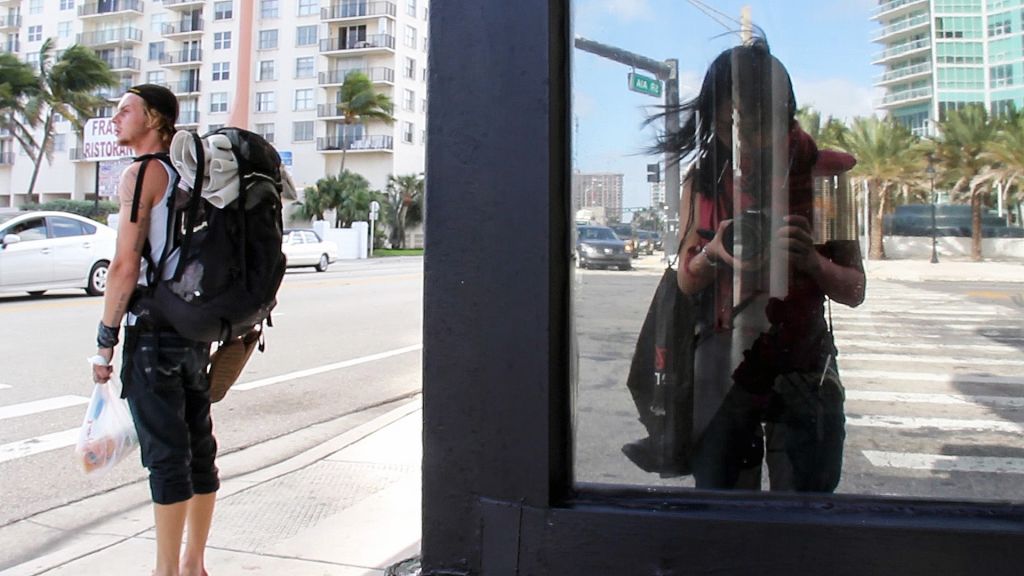
Nanfu Wang was a student at NYU when she went exploring America, which found her in Florida staying at a hostel. There she encountered a young drifter named Dylan, whom she found fascinating enough to start filming, capturing his experiences living on the streets while she stayed right there with him. But then she went back to her native China to make a film called Hooligan Sparrow, in which she experienced a different kind of danger to life on the streets: filming a group of activists who were marked enemies of the state, Nanfu found herself facing destroyed cameras and intimidation, and eventually had to smuggle footage out to get that film made. Hooligan Sparrow went on to air on PBS’s POV and win a number of awards, including being shortlisted for an Oscar.
She then went back to Dylan’s story, with a new perspective under her belt after the Sparrow experience. She probed Dylan’s life in new and impactful ways, and the resulting film, I Am Another You, is all the more powerful for it.
“One of the most striking and enthralling nonfiction films this reviewer has seen in years, I Am Another You almost seems designed to prove that great documentaries require large measures of both talent and luck.” – Godfrey Cheshire, RogerEbert.com
Why initially led you to want to make this film, to make a film about Dylan’s story?
Curiosity was the major drive for me to make the film. When I met Dylan, I was curious about his choice of living on the streets and his depiction of the freedom he enjoyed. After following him for a while, the desire to know more drove me to find his family and to understand more about the culture and background that produced him.
Eventually, I wanted to know how his mind worked and what was his thought process. The goal of making the film, though, is to generate compassion and willingness to understand individuals like Dylan.
What were some of the biggest challenges you faced in making I Am Another You?
Finding a place to charge the battery was the biggest challenge. At night, we usually moved three or four times, woken up by the police, security guards, rain, or sprinklers. I had to charge the battery during the day, so every day I would have to find an outlet and wait there for a few hours until the batteries were fully charged. It was very inconvenient.
Since you did have to spend some time living in the streets (and parks) for this film, as you mention, did you ever fear for your own safety? What about when you went to spend the night at a stranger’s house – what made you feel that was going to be okay?
Not at all. Dylan was very street smart. He gave me a lot of tips about surviving on the street – how to decide where was a safe place to spend a night; what signs of danger to look out for, etc. One time, he pulled out a knife from his pocket and said to me, “The story you tell is more important than my life. If anyone tries to take your camera or your computer, I’ll fight with my life.” He protected me and I felt very safe.
What discussions or conversations would you like audiences who see your film, to have afterward? What would you hope people would take away from it?
Everyone will have an opinion about Dylan. Because we see homeless people on the street every day, everyone will feel that they know people like Dylan. I hope the film would challenge people’s preconceived notions about homelessness, mental health issues, and topics that are depicted in the film.
Audiences had very positive responses so far. They’re moved by Dylan’s story and felt that they hadn’t really understood people like Dylan until they saw the film. Most people know someone who is like Dylan and seeing his story gave them insight into the lives of the people they know.
You mention in the film how your family wouldn’t quite understand you sleeping on the streets. Have you shown them this film? What was their reaction to it if so?
They still haven’t seen it. I will need to subtitle it in Chinese for them to watch it.
What about Dylan and Dylan’s family?
All the main characters have seen the film prior to its public screening. Dylan said, “It’s very rare that anyone like me would ever get his story told, let alone being told in such artistic way. I really appreciate it.” His father John said, “It’s a beautiful film. It helped me understand many things about Dylan and about myself that I didn’t know before.”

Is there a particular scene or moment in the film that especially moved or resonated with you?
When Dylan’s father John shared his video diary with me, I felt extremely honored and moved. The video journals have been so personal and private to him that even Dylan didn’t know they existed. When I asked John why he decided to show them to me and allow me to use them in the film, he said, “because I hope this film can help Dylan. Of course, I feel vulnerable to open up and to be in a film, but I’d do anything for Dylan if it might possibly help him.”
Do you have any updates on Dylan since filming stopped? Anything you can share?
Dylan is still traveling. He attended the film’s premiere at SXSW in March 2017. After that, he traveled to Hawaii, California, Utah, among many other places.
What films/projects are you working on or hoping to work on next?
I became a mother in September 2017, and I’m working on a film about the untold history of China’s one-child policy and generations of mothers and children whose lives have been forever changed by this haphazard, draconian governmental social experiment.

